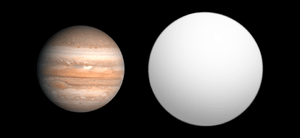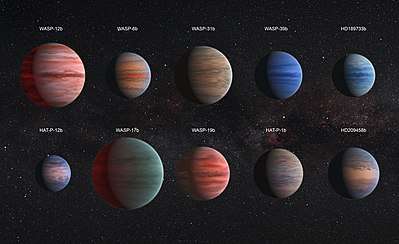WASP-19b
| Exoplanet | List of exoplanets | |
|---|---|---|
 | ||
| Parent star | ||
| Star | WASP-19 | |
| Constellation | Vela | |
| Right ascension | (α) | 09h 53m 40.0765s[1] |
| Declination | (δ) | −45° 39′ 33.056″[1] |
| Apparent magnitude | (mV) | 12.3 |
| Distance | 882±6[1] ly (270±2[1] pc) | |
| Spectral type | G8V[2] | |
| Mass | (m) | 0.95[2] M☉ |
| Orbital elements | ||
| Semi-major axis | (a) | 0.01655±0.00013[2] AU |
| Eccentricity | (e) | 0.0046+0.0044 −0.0028[2] |
| Orbital period | (P) | 0.78884±0.0000003[3] d |
| (18.93216 h) | ||
| Inclination | (i) | 79.4±0.4[2]° |
| Time of transit | (Tt) | 2455168.96801±0.00009[2] JD |
| Physical characteristics | ||
| Mass | (m) | 1.168±0.023[2] MJ |
| Radius | (r) | 1.386±0.032[2] RJ |
| Density | (ρ) | 680[3] kg m−3 |
| Bond Albedo | (Ab) | 0.38±0.06[4] |
| Geometric Albedo | (Ag) | <0.26 [5] |
| Temperature | (T) | 2350+168 −314[6] |
| Discovery information | ||
| Discovery date | December 10, 2009[3] | |
| Discoverer(s) | Hebb et al. (SuperWASP)[3] | |
| Discovery method | Transit[3] | |
| Other detection methods | Radial velocity, Secondary transit | |
| Discovery status | Published[3] | |
| Database references | ||
| Extrasolar Planets Encyclopaedia | data | |
| SIMBAD | data | |
| Exoplanet Archive | data | |
| Open Exoplanet Catalogue | data | |
WASP-19b is an extrasolar planet, notable for possessing one of the shortest orbital periods of any known planetary body: 0.7888399 days or approximately 18.932 hours. It has a mass close to that of Jupiter (1.15 Jupiter masses), but by comparison has a much larger radius (1.31 times that of Jupiter, or 0.13 Solar radii); making it nearly the size of a low-mass star.[3] It orbits the star WASP-19 in the Vela constellation. It is currently the shortest period hot Jupiter discovered as planets with shorter orbital periods have a rocky, metallic or degenerate matter composition.
In 2013, secondary eclipse and orbital phases were barely observed from the data gathered with ASTEP telescope, making it the first detection of such kind through ground-based observations. This was possible due to large size of the planet and its small semi-major axis.[5]
Atmosphere
In December 2013, scientists working with the Hubble Space Telescope reported detecting water in the atmosphere of the exoplanet.[7][8]
In September 2017, astronomers using the Very Large Telescope at the European Southern Observatory reported the detection of titanium oxide (TiO) in WASP-19b's atmosphere.[6] This was the first time titanium oxide had been detected in an exoplanet atmosphere.[9] They also detected a strongly scattering haze in the atmosphere as well as the element sodium, and additionally confirmed the presence of water.[6]

From top left to lower right: WASP-12b, WASP-6b, WASP-31b, WASP-39b, HD 189733b, HAT-P-12b, WASP-17b, WASP-19b, HAT-P-1b and HD 209458b.
References
- 1 2 3 4 Brown, A. G. A.; et al. (Gaia collaboration) (August 2018). "Gaia Data Release 2: Summary of the contents and survey properties". Astronomy & Astrophysics. 616. A1. arXiv:1804.09365. Bibcode:2018A&A...616A...1G. doi:10.1051/0004-6361/201833051. Gaia Data Release 2 Vizier catalog entry
- 1 2 3 4 5 6 7 8 "Notes for planet WASP-19b". The Extrasolar Planets Encyclopaedia. Retrieved 2009-12-10.
- 1 2 3 4 5 6 7 Hebb, L.; et al. (2010). "WASP-19b: The Shortest Period Transiting Exoplanet Yet Discovered". The Astrophysical Journal. 708 (1): 224–231. arXiv:1001.0403. Bibcode:2010ApJ...708..224H. doi:10.1088/0004-637X/708/1/224.
- ↑ Wong, Ian; et al. (2016). "3.6 and 4.5 μm Spitzer Phase Curves of the Highly Irradiated Hot Jupiters WASP-19b and HAT-P-7b". The Astrophysical Journal. 823 (2). 122. arXiv:1512.09342. Bibcode:2016ApJ...823..122W. doi:10.3847/0004-637X/823/2/122.
- 1 2 https://arxiv.org/abs/1303.0973
- 1 2 3 Sedaghati, Elyar; et al. (2017). "Detection of titanium oxide in the atmosphere of a hot Jupiter". Nature. 549: 238-241. arXiv:1709.04118. Bibcode:2017Natur.549..238S. doi:10.1038/nature23651.
- ↑ Staff (3 December 2013). "Hubble Traces Subtle Signals of Water on Hazy Worlds". NASA. Retrieved 4 December 2013.
- ↑ Mandell, Avi M.; et al. (2013). "Exoplanet Transit Spectroscopy Using WFC3: WASP-12 b, WASP-17 b, and WASP-19 b". Astrophysical Journal. 779. 128. arXiv:1310.2949. Bibcode:2013ApJ...779..128M. doi:10.1088/0004-637X/779/2/128.
- ↑ "Inferno World with Titanium Skies" (Press release). European Southern Observatory. September 13, 2017. Retrieved December 24, 2017.
External links
![]()